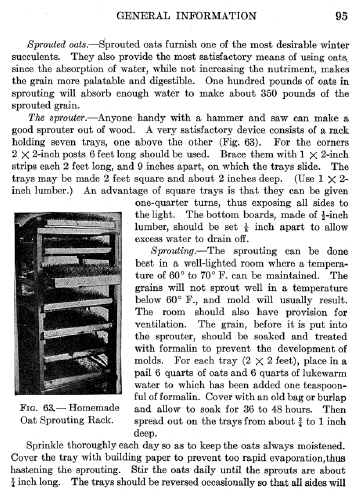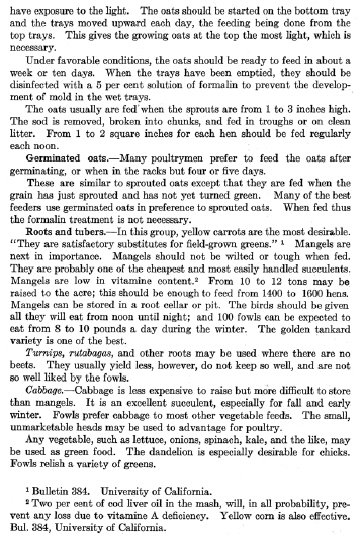



Pastured Poultry Nutrition and Forages: Summary and References
This publication explores the important role that forages play in pastured poultry production for either meat or egg production. Research on the effects of raising poultry on pasture has increased greatly in recent times, with an ever-growing body of scientific work. Special attention to the nutritional benefits of poultry foraging on pasture: regarding is paid to both the birds’ health and the impact that forages have on the nutritional and flavour qualities of the meat and eggs. By Terrell Spencer, Agriculture Specialist with the US National Center for Appropriate Technology (NCAT).Introduction: Forage’s Historical Role in Poultry Rations
Raising poultry on pasture is a time-established method of farming quality chickens, turkeys, waterfowl, and other poultry. Historically, before the maturation of poultry nutritional science and the widespread availability of balanced rations, forages were an important component of poultry diets. Access to vegetation was a way of providing a multitude of critical vitamins and minerals, many unknown until the middle of the 20th century, to meet a flock’s nutritional needs.
The importance of the vegetation that poultry consumed while on pasture can be seen in the following excerpt from a 1930 poultry-production textbook: “At all times of the year, an abundance of green feed is necessary. A lack of it is often a cause of ill health and low production. It acts as a tonic in functioning properly, securing for the bird a larger utilization of the feed consumed. The principal value, therefore, is in maintenance of health. The importance of abundance, as well as a variety, of green feed is seldom fully realized.” (Rice and Botsford, 1930)
For hundreds of years, small farm flocks were allowed to roam and scavenge most of their diet from a farm’s pastures, barnyards, orchards and fields, with occasional supplementation from scratch grains and table and garden scraps. The leaves and seeds the birds ingested, as well as the insects that were quickly gobbled up (often full of freshly consumed plant matter), helped balance out any of the unknown deficiencies in the feed ration. Indeed, before the middle of the 20th century, forages were the only reliable source for necessary nutrients like vitamin A, critical in preventing devastating diseases.
As poultry farms grew larger as the 20th century progressed, the ways that farmers incorporated greens into the diets of their birds were as varied as the farmers themselves. Many farmers would let their flocks freely graze around the colony houses/coops where the hens lived and laid their eggs.
Where climate, space, and economics allowed, other farmers would plant grains such as barley, oats or winter wheat for the birds to graze while the grains were young and still appetising. This practice was especially helpful in the winter, when few other forages were present. Similarly, some farmers managed poultry-friendly pastures - filled with ryegrass, clovers or other highly palatable forages - for laying flocks. By midsummer, when the flocks had consumed most of the available forages and the invertebrate populations become scarce, greens or fodder crops would be supplied from a truck patch or even garden pickings.
On many farms, greens - primarily kale - were grown specifically to harvest as poultry feed. Reviewing old poultry accounts, one variety of kale is frequently referenced: 1,000-headed kale. This kale was prized by many poultry farmers over other greens due to its prolific and hardy nature. Plants could easily approach six feet tall, and the large leaves were harvested as needed in a “cut and come again” fashion.
Lavelle Donovan, who grew up on a poultry farm in California in the 1920s, recalls: “Chicken greens were kale or a low vine called rape which was cut with a scythe. I can still see my father in the kale patch. He'd pick a kale leaf and tuck it under his arm until he collected a bunch. Then he'd put the bunch in a burlap bag he dragged along tied to his waist. Then he chopped up the leaves with the kale cutter in the barn.” (Lowry, 1993)
The larger and more confinement-based the farm, the more greens were needed. The largest farms grew at least a couple of acres of kale and other greens, usually transplanted by hand, for their poultry rations.
Other farmers used different strategies to get greens into their flocks when forages became scarce.
Supplementing rations with green additions like alfalfa or grass meal - a strategy still well-advised today - was considered essential to provide sources of unidentified nutrients (Blair, 2008). Sprouted grains such as oats or wheat (see Appendix 1 – Oat Sprouter), or vegetables like kale and cabbage, were also fed to the flock at regular intervals.
Feeding rootstocks like mangels (a type of large beet for livestock) or carrots during the winter, along with winter-hardy greens, was a routine practice, providing a nutritional boost and also helping to reduce excessive pecking in flocks during the winter by keeping the hens preoccupied.
Chapters in Pastured Poultry Nutrition and Forages
- Advantages of Forage Consumption by Poultry
- Forage Impacts on Poultry Meat and Egg Quality
- Factors Affecting Forage Consumption
- Insects and Other Animals as Forages / Utilising Native Pastures / Establishing Poultry Pastures / Protecting Pasture from Poultry
References
Bassler, A. 2005. Organic broilers in floorless pens on pasture. PhD Thesis. Swedish University of Agricultural Sciences, Uppsala, Sweden.
Blair, R. 2008. Nutrition and Feeding of Organic Poultry. CAB International Publishing, Oxfordshire, UK.
Buchanan, N., J. Hott, L. Kimbler and J. Moritz. 2007. Nutrient composition and digestibility of organic broiler diets and pasture forages. Journal of Applied Poultry Research. 16(1):13-21.
Buxton, D. and D. Redfearn. 1997. Plant limitations to fiber digestion and limitation. Journal of Nutrition. 127(5):814S-818S.
Coffey, L., M. Hale, T. Terrill, J. Mosjidis, J. Miller and J. Burke. 2007. Tools for Managing Internal Parasites in Small Ruminants: Sericea Lespedeza. National Center for Appropriate Technology: ATTRA Publication IP316.
Davtyan, A. and V. Manukyan. 1987. Effect of grass meal on fertility of hens. Ptitsevodstvo. 6:28-29.
Dawkins, M., P. Cook, M. Whittingham, K. Mansell and A. Harper. 2003. What makes free-range chickens range? In situ measurement of habitat preference. Animal Behaviour. 66: 151-160.
de Almeida, G., L. Hinrichsen, K. Horsted, S. Thamsborg and J. Hermansen. 2012. Feed intake and activity level of two broiler genotypes foraging different types of vegetation in the finishing period. Poultry Science. 91(9):2105-2113.
Eriksson, M. 2010. Protein supply in organic broiler production using fast-growing hybrids. PhD Dissertation. Uppsala, Sweden.
Esmail, S. 2012. Fibre plays a supporting role in poultry nutrition. World Poultry Magazine. February 2012.
Gorksi, B. 2000. Nutritional Analysis of Pastured Poultry Products. APPPA GRIT! American Pastured Poultry Producers Association. Vol. 11. p1-3.
Heuser, G. 1955. Feeding Poultry: The Classic Guide to Poultry Nutrition for Chickens, Turkeys, Ducks, Geese, Gamebirds, and Pigeons. Norton Creek Press, Blodgett, OR. Reprinted 2003.
Horsted, K. 2006. Increased Foraging in Organic Layers. PhD Thesis. Department of Agroecology, University of Aarhus. Faculty of Agricultural Sciences.
Horsted, K., J. Hermansen and H. Ranvig. 2007. Crop content in nutrient-restricted versus non-restricted organic laying hens with access to different forage vegetations. British Poultry Science. 48:177-184.
Jones, R. 1986. Responses of domestic chicks to novel food as a function of sex, strain and previous Experience. Behaviour Processes. 12. p261-271.
Kains, M. 1920. Profitable Poultry Production. James A McCann Publishing, New York, NY.
Karsten, H., P. Patterson, R. Stout and G. Crews. 2010. Vitamins A, E, and fatty acid composition of the eggs of caged hens and pastured hens. Renewable Agriculture and Food Systems. 25(1):45-54.
Long, C. and T. Alterman. 2007. Meet real free-range eggs. Mother Earth News. October/November. p4.
Lopez-Bote, J.,A. Sans, A. Rey, A. Castano, B. Isabel and J. Thos. 1998. Effect of free range feeding on n-3 fatty acid and a-tocopherol content and oxidative stability of eggs. Animal Feed Science Technology. 72:33-40.
Lowry, T. 1993. Petaluma’s Poultry Pioneers. Manifold Press, Ross, CA.
Mattocks, J. 2002. Pasture-Raised Poultry Nutrition. National Center for Appropriate Technology: ATTRA Publication IP 227.
Mortiz, J., A. Parsons, N. Buchanan, N. Baker, J. Jaczynski, O. Gekara and W. Bryan. 2005. Synthetic methionine and feed restriction effects on performance and meat quality of organically reared broiler chickens. Journal of Applied Poultry Research. 14:521-535.
Moyle, J., J. Burke, A. Fanantico, J. Mosjidis, T. Spencer, K. Arsi, I. Reyes-Herrera, A. Woo-Ming, D. Donoghue and A. Donoghue. 2012. Palatability of tannin-rich sericea lespedeza fed to broilers. Journal of Applied Poultry Research. 21:891-896.
National Research Council. 1966. Nutrient requirements of dairy cattle, 3rd edition. National Academy of Sciences, Washington, DC.
Nurmi, E. and M. Ratala. 1973. New aspects of Salmonella infection in broiler production. Nature. 241:210-211.
Ponte, P., J. Prates, J. Crespo, D. Crespo, J. Mourão, S. Alves, R. Bessa, M. Chaveiro-Soares, L. Ferreira and C. Fontes. 2008a. Improving the Lipid Nutritive Value of Poultry Meat Through the Incorporation of a Dehydrated Leguminous-Based Forage in the Diet for Broiler Chicks. Poultry Science. 87:1587-1594.
Ponte, P., J. Prates, J. Crespo, D. Crespo, J. Mourão, S. Alves, R. Bessa, M. Chaveiro-Soares, L. Ferreira, and C. Fontes. 2008b. Restricting the Intake of a Cereal-Based Feed in Free-Range-Pastured Poultry: Effects on Performance and Meat Quality. Poultry Science. 87:2032-2042.
Pousga, S., H. Boly and B. Ogle. 2005. Choice feeding of poultry: a review. Livestock Research for Rural Development. 17:45.
Rice, J. and H. Botsford. 1930. Practical Poultry Management. Braunworth & Co, Brooklyn, NY.
Rivera-Ferre, M., M. Guadalupe, E. Lantinga and R. Kwakkel. 2007. Herbage intake and use of outdoor area by organic broilers: effects of vegetation type and shelter addition. NJAS-Wageningen Journal of Life Sciences. 54:279-291.
Rybina, E. and T. Reshetova. 1981. Digestibility of nutrients and biochemical values of eggs in relation to the amount of lucerne and grass meal and the quality of supplementary fat in the diet of laying hens. Zhivotnovodstva. 35:148-152.
Salatin, J. 1996. Pastured Poultry Profit$. Polyface Inc., Swoope, VA.
Salatin, J. 2001. Grass Conversion Rates by Poultry. APPPA GRIT! American Pastured Poultry Producers Association. 15:3-4.
Silverman, A. 2000. The ’Pasture’ in Pastured Poultry: An Oregon View. APPPA GRIT! American Pastured Poultry Producers Association. 12:9.
Silverman, A. 2001. The ‘Pasture’ in Pasture Poultry, Continued. APPPA GRIT! American Pastured Poultry Producers Association. 18:14-15.
Sun, T., Z. Liu, L. Qin, and R. Long. 2012a. Aspects of lipid oxidation of meat from free-range broilers consuming a diet containing grasshoppers on alpine steppe of the Tibetan Plateau. Poultry Science. 91:224-231.
Sun, T., Z. Liu, L. Qin, and R. Long. 2012b. Meat fatty acid and cholesterol level of free-range broilers fed on grasshoppers on alpine rangeland in the Tibetan Plateau. Journal of the Science of Food and Agriculture. 92:2239-2243.
Todd, A.C. and B.J. McSpadden. 1947. Pastures for chickens and their relation to the parasitic fauna. Poultry Science. 26:576-581.
Appendix: : Sprouted Oats
Source: Practical Poultry Management by J. Rice and H. Botsford. 1930.


October 2013








